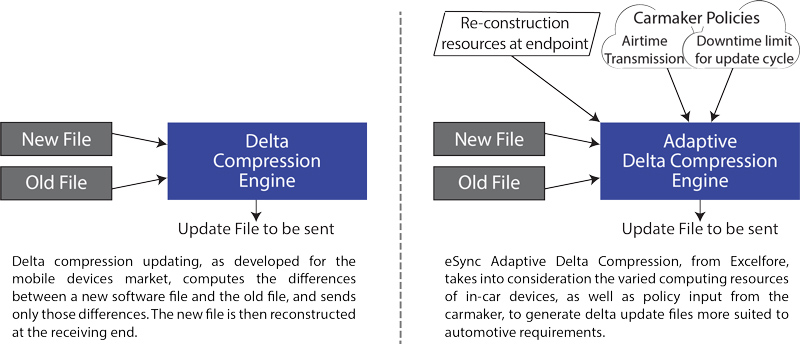Automotive OTA updates optimised with delta compression
Enabler of smart mobility networks, Excelfore has announced the eSync Adaptive Delta Compression Engine, which is used by the Excelfore eSync OTA Server to optimise Over-The-Air (OTA) software updates for vehicles.
The engine optimises compression of software updates for OTA delivery within the particular environment of the automotive industry. It enables carmakers to minimise service costs, airtime costs and vehicle downtime, while increasing customer satisfaction.
A software delta update downloads only the differences between a new version of software and the prior version, reducing the amount of data that must be transmitted. The full new version of the software is then reconstructed locally. When there are millions of vehicles, delivering delta updates is an effective mechanism to reduce airtime requirements and transmission costs.
The Adaptive Delta Compression Engine uses binary differencing algorithms that have been enhanced with Excelfore’s patented dynamic compression technology (US Patent 8,949,466), enabling it to dynamically adjust compression techniques to the unique requirements of delta updates in the automotive industry.
Carmakers who provide OTA updates often use delta compression schemes developed for the smartphone market. These do not consider the substantial vehicle downtime while new software is decompressed, reconstructed, and installed in many electronics devices in today’s connected car.
Excelfore has improved on existing OTA techniques by using an adaptive approach. The Adaptive Delta Compression Engine selects an update and compression strategy to match the specific computational resources of each end device in the vehicle, within the context of policies set by the car maker. This allows car makers to optimise not only for file size and airtime savings, but also to minimize vehicle downtime, enhancing customer satisfaction.
The eSync System is a cloud platform for secure transactions with the vehicle, and with the various electronic end devices within the vehicle. It can be used to deliver and update software and firmware over the air, as well as for pulling diagnostics and telematics data from the devices in the vehicle.






